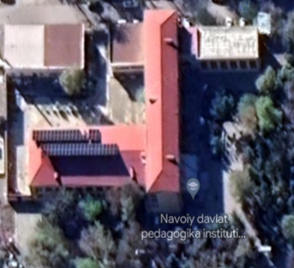Green campus
| No. | Name
| Place
| automation | safety | energy | water | Indoor environment | lighting | Building Area (m²)
| ||||||||||||
| B1 | B2 | S1 | S2 | S3 | S4 | E1 | E2 | A1 | A2 | I1 | I2 | I3 | I4 | L1 | L2 | L3 | L4 | ||||
| University X; Building A | Navoi | + | + | + | + | + | |||||||||||||||
| University X; Building B | Navoi | + | + | + | + |
+ | |||||||||||||||
| University X; Building C | Navoi | + | + | + | + | + | |||||||||||||||
| University X; Building D | Navoi | + | + | + | + | + | |||||||||||||||
| Navoi | + | + | + | + | + | ||||||||||||||||
| Navoi | + | + | + | + | + | ||||||||||||||||
| Navoi | + | + | + | + | + | ||||||||||||||||
| Total | |||||||||||||||||||||

Note: One building could be classified as a smart building if it has a minimum of 5 features. Please add the total smart building area from buildings which are classified as smart buildings.
All structures of institute are operating as smart buildings. Building management systems were connected together which possible to share information that can be used to automate various processes such as heating, lightning, air conditioning and security. Temperature and humidity indicators are available in all the classrooms and connected to air conditioner. These tools enable to operate the air conditioners remotely, which assists to prevent overusing energy. Moreover, windows are widely constructed to reduce energy and improve accessibility of natural light.
Automotive gate


Safety and security cameras



Temperature and humidity indicator and Smoke detector
Motion sensor and Solar lamp and solar panel
Ecosystem Preservation: Preserving existing trees and vegetation to maintain local biodiversity.
Recycled Materials: Using materials that are recycled or salvaged to reduce waste and resource consumption
Insulation and Windows: Using high-quality insulation and energy-efficient windows to minimize energy loss.
Renewable Energy: Incorporating solar panels to generate clean energy.
Energy Management Systems: Implementing smart systems to monitor and control energy use effectively
Low-Flow Fixtures: Installing low-flow faucets, showerheads, and toilets to reduce water consumption.
Rainwater Harvesting: Collecting and utilizing rainwater for irrigation and non-potable uses.
Daylighting: Optimizing natural light in occupied spaces to enhance occupant comfort and reduce energy use.
Air Quality: Maintaining good indoor air quality through proper ventilation and the use of low-emission materials.
Education Programs: Providing information and training on sustainable practices for occupants and facilities managers.
As we know, implementing green building practices is a multifaceted approach that requires careful planning, collaboration, and commitment. By focusing on sustainability at every stage—from site selection to occupant engagement—developers can create buildings that are not only energy-efficient but also contribute positively to the environment and community. Continuous innovation and adherence to best practices in green building will be essential for meeting the evolving challenges of climate change and urbanization.
Solar panel (Navoi state pedagogical institute, Uzbekistan)


Solar lamp (Navoi state pedagogical institute, Uzbekistan)
Led lamp, motion sensor (Navoi state pedagogical institute)


Water purification system (Navoi state pedagogical institute)
Water purification system (Navoi state pedagogical institute)
Navoi State Pedagogical Institute has planned to build a new campus that will be in accordance with sustainable standards, which will adopt solar panels for the generation of electricity and is expected to be a smart building creating a safe and comfortable atmosphere. Our main focus is the installation of solar panels since it bolsters all our efforts to achieve our goals in reducing the emission of carbon and other detrimental substances into the air and our commitment to play a huge role in transitioning from a world struggling with global problems to low-carbon, clean environment future.
Since cars are the main contributors to air contamination, NSPI tries to do its part by reducing the usage of cars inside the campus by decreasing the space for parking lots and expanding green space. Furthermore, to advocate for the use of electric cars our institute offers charging stations for e-cars. Pedestrian pathways cycling tracks, and other storage spaces for bike and scooter users are the highlight of our plans to reduce carbon emissions. Navoi State Pedagogical Institute prioritizes a good state of the environment and takes measures to promote sustainability throughout our campus. Therefore, carbon footprint is regularly tracked by the institute and we pay attention to taking actions to reduce carbon emissions. For example, there was a bigger parking zone with a capacity of 150 cars in the territory of the institute 4 years ago. Due to the new environmental policy of the institute, the parking area has decreased in size. Currently, only 30 vehicles can be parked at the campus parking zone and a parking fee is charged. Moreover, 70 free bicycles are provided for use by the institute administration.





